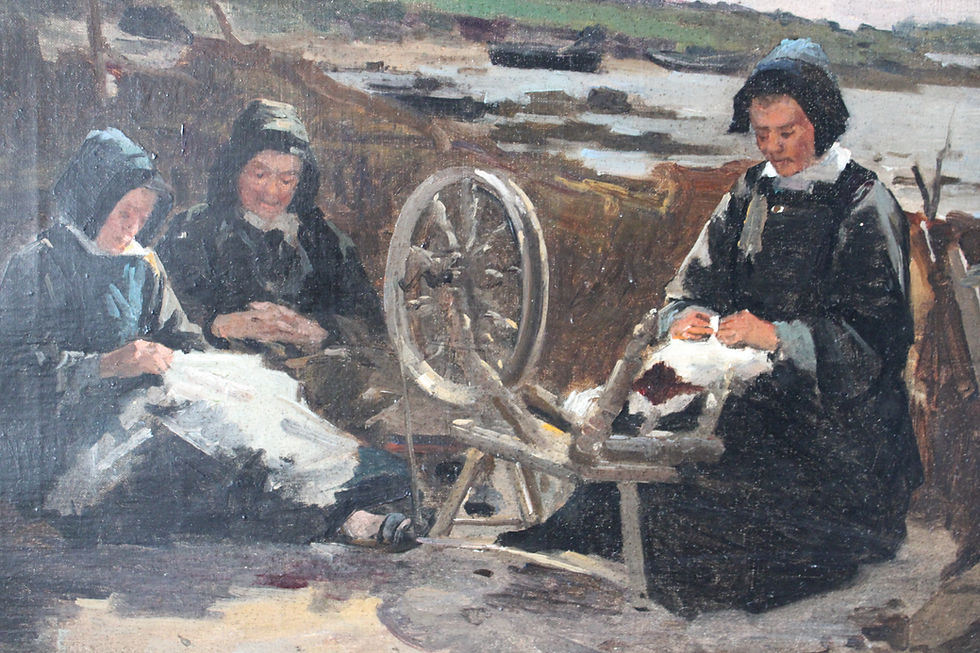Original large antique riverside oil painting on canvas by French artist Eugene Galien-Laloue (1854-1941). A calming and traditional French oil on canvas by this respected and renown artist. A river winds it's way around the landscape, flanked by tall trees on the far bank which are reflected in the cool waters. On the near side a cottage sits within the landscape very near to the river where boats await. A woman feeds her chickens. A truly atmospheric original oil painting that has captured the most beautiful gentle lilac light.
MORE ABOUT THIS PAINTING:
Medium: Oil on stretched canvas
Painting size: 20ins x 26ins or 50cms x 66cm
Size with frame: 29ins x 34ins or 74cms x 87cmsDate: 1800's
Condition: The painting is in good antique condition. It has been professionally cleaned, relined and repaired at some point in time, quite likely within the last 20 years. There is a repair to the left of the painting through the tall trees. The frame is vintage, it has minor imperfections associated with an item of this age and a piece of moulding missing at the top.
Signed: Dumoutier one of the many pseudonyms of Eugene Galien-Laloue (1854-1941). He was born on December 11, 1854 in Montmartre, the oldest of eventually nine children. He exhibited for the first time in 1876 at the Museum of Reims, showing Le quai aux fleurs par la neige (Flower Market Along the Seine Under the Snow). The following year he exhibited for the first time at the annual Parisian Salon, showing En Normandie (In Normandy) as well as two gouaches. He preferred executing gouaches since they were less time consuming than his oils and brought comparable prices. At this time his teacher was listed as being M.C. Laloue, Claude Laloue, perhaps his late father who would have taught him a more academic approach or an uncle.
From the beginning of his career and perhaps spurred by his travels along the railway lines, Galien Laloue became interested in showing the natural environment. While not uncommon, it was perhaps an interesting theme for an artist who did not necessarily seek to connect with nature and while painting en plein-air. He had a reclusive personality, which also may explain the reasons behind his numerous pseudonyms. He preferred the solitariness of his studio and thus did not paint his works entirely on-site. Unlike many other artists as well, he did not like to travel and many of his views of other cities or countries were inspired by postcards and photographs, an increasing tendency with many artists as photography became a more established method of use.
During the first two decades of the twentieth century he also exhibited at Dijon, Orléans, Versailles, Roubaix, Saint Etienne, Bordeaux, Monte Carlo, Hautecoeur, among several other cities. Galien Laloue continued to paint until 1940, when he broke the arm with which he held his brush. Despite his reluctance to integrate himself with others, his paintings offer a record of late nineteenth and early twentieth century Paris, focusing not so much on the relationship between its citizens, but more so on the architectural aspects of the city.
He moved out of Paris many times to depict the landscapes of Normandy and the surroundings of Barbizon, making his home for a short time in Fontainebleau. While his Parisian scenes were often of the fall and winter, he preferred to document the landscape during the brighter months of spring and summer. He also documented life along the canals and banks of the sea and rivers as in this painting. He became very popular with both French and especially American artists and continued to paint the same scenes of Paris throughout his career. He died in his daughter’s house in Chérence, where they had taken refuge at the beginning of the Second World War, on April 18th, 1941.
USA CLIENTS - WORRIED ABOUT TARIFFS?
Don't be, we send all our paintings with the correct paperwork to ensure they are delivered tariff free.
top of page
1 599,00 €Prix
Tous les articles
* FREE WORLDWIDE SHIPPING * PURCHASE TAXES INCLUDED *
bottom of page

























